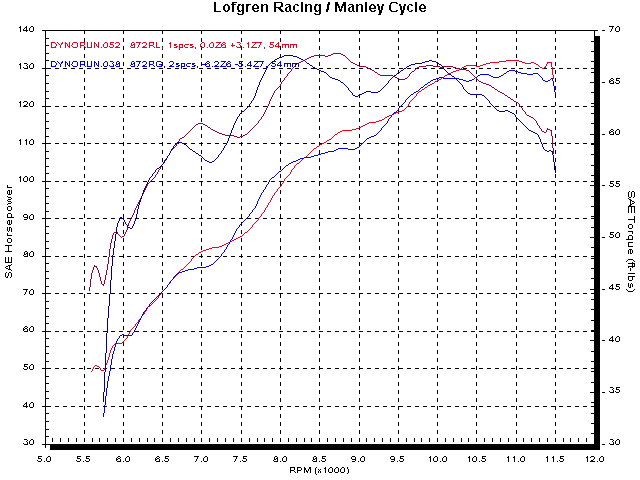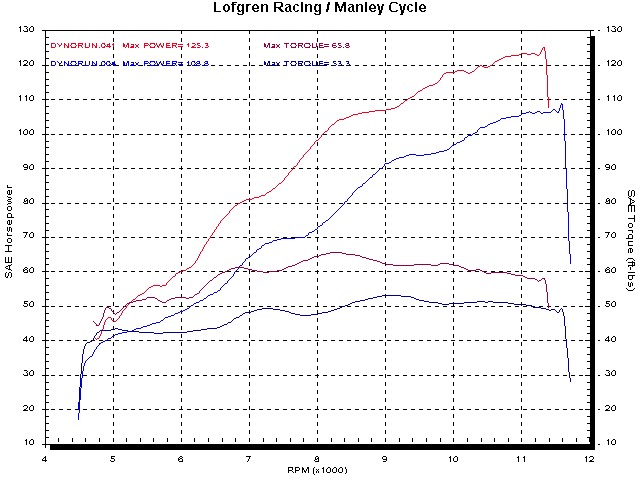
Craig Conway's 853R
My reports have been thrown together and rarely re-visited. Because of this there are a lot of omissions. Some of the things that are left out are omitted for a purpose, some are just underplayed.
For instance; on Milchek's 872R I spent a lot of time testing inlet length and it's effect on the torque curve. I tried this because of a theory I'd had, having to do with the Pro-Thunder bikes. Basically, I had heard that some of the Pro-Thunder competitor were changing the cam timing to lower the peak power RPM. This was an attempt to increase the valve train life. I had also heard that the power dropped significantly when the peak power RPM decreased. Knowing that the inlet length can limit the upper RPM range of an engine, and assuming that Ducati had designed the inlet length of the 748RS to allow the stratospheric RPM that was necessary to compete in World Supersport, I felt that an increase in inlet length may have been overlooked by some of the people who were running the narrow lobe center cam timing in Pro-Thunder.
I didn't mention it because I didn't want to give away what I learned. Well, here it is;
Here's what extending the inlet length does. It shifts all of the torque tuning points a little lower.
I had to create entirely different fuel maps for each of these configurations, so I could be sure what each change was doing.
The brown trace is the torque associated with the single 15mm velocity stack extension. As it happens, the torque curve of Gary's 872R with the 54mm Arrow system, fell off more at the power peak with 2 spacers, so the single spacer helps the peak power by pushing the torque up. In this case, the engine's ability to breath is beginning to suffer after 11,000 RPM without the help of the resonant tuning (a combination of the exhaust pipe resonance and inlet length resonance) the peak power is compromised. The power with two spacers is a little better at 9,700 RPM and quite a bit better at 7,800 RPM, but the marginal increase at 9,700 implies that the volumetric efficiency is going away.

Gary posted some photos of his throttle bodies and air-box and they show the spacers. How many people noticed?
Take a look http://public.fotki.com/garymilcheck/motorcycles/748r/airbox_and_injectio/
I don't build very many Ducati engines. Craig's is only the second 748R that I've had apart. The design of each has to be sound and it has to have custom fuel and ignition maps developed to see all the potential. And, seeing all the potential, allows one to assess the effectiveness of the modifications.
What's the point?
Whatever successful results have been achieved with these two 748Rs is due entirely to my capability to create the fuel and ignition maps for these bikes.
Because of that capability I can learn more from each job. If I couldn't create the maps that each engine needs, I couldn't tell whether the results (or lack of results) are caused by fuel mapping problems, or ignition timing, or design shortcomings.
853R
Craig's bike had really low miles, so he didn't want to go into the bottom end and replace the titanium rods. I had to decide what changes were needed to get the best result without changing the rod length, which was a major help in getting the extra compression from Milchek's 872R.
One thing that seemed to help make some power was the Akropovic pipe. It's a thing of beauty that goes to 60mm from the crossover to the mufflers. It appears to help the top end power a fair amount. But, since the inlet ports are so bad, they can vary a lot and that variation may explain the power variations from one 748R to another.
I used BCM flat-top 94mm Pistal pistons. I had to re-cut the valve clearance pockets for the different valve centerline of the 748R. Both the inlet and exhaust valve centerlines are narrower than on the 851/888/916/996 heads. Apparently the 36mm inlet valves flow a little better when they are farther from the cylinder wall in spite of the losses due to being closer together.
Because the pistons didn't have a dome, I didn't open up the combustion chamber, retaining as much compression as possible.
The throttle bodies still needed to be modified to eliminate the turbulence caused by the built-in 44mm restriction.
And the ports still needed to be fixed.
As with Milchek's, I made velocity stack extensions to lower the peak RPM point and slightly increase the torque, partially offsetting the losses associated with lowering the peak RPM. The shift in RPM tuning points is the result of the larger displacement plus, the 15mm inlet extension.
Because of this shift, the fuel map needs some tweaking to get a good A/F ratio across the WOT.

I've touched on all of the important aspects of this engine. This means that you can build one too. Plus, I have a pretty good map for it. Just ask.